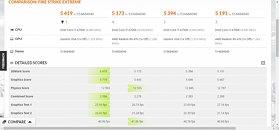Wednesday, April 5th 2017

AMD's RX 580, 570 and RX 550 Specifications and 3D Mark Results Leak
So, it would appear that rumors and leaks about the RX 500 series being simple rebrands of AMD's RX 400 line were true. Recent leaks point to no more changes and performance increases than those achieved through higher base clock speeds on the graphics cards' GPU and memory. The architecture is the same, and the process seems to have followed the same path - as of yet, no confirmation regarding whether or not these cards do use a newer, leaner LPP process for higher clocks and less power consumption.The RX 580 will come in with clocks at 1340 MHz with 4 GB and 8 GB GDDR5 variants clocking in at 8.0 GHz along a 256-bit bus interface. This amounts to 256 GB/s of bandwidth, and pricing should be around the $199 - $249 mark. On the leaked Firestrike Extreme test, this card was clocked to 1500 MHz (not easy to achieve with current Polaris 10 GPUs) and a 6675 points score. The RX 570, on the other hand, seems to have not been given the core clocks bump treatment, but memory speeds should see an increase to 7 GHz, delivering 224 GB/s of bandwidth. Overclocked to 1325 MHz, it delivered a score of 5719 points in the same benchmark. Finally, the new kid on the block, AMD's Polaris 12 is somewhat of a head-scratcher of a part, with its measly 640 stream processors (the line between discrete graphics and integrated ones is really blurry here). RX 550 reference cards should come in at 1190 MHz, where it scores 1849 in 3DMark FireStrike Extreme, though the card does so with only PCIe power.Pricing should be in line with AMD's RX 400 series, and performance should be comparable to RX 400 AIB cards, so no setting the world on fire here. If delay reports are true, expect these to be launched on April 18th. The RX 560 is MIA for now, but there is no reason to think it won't be launched alongside the other cards in the RX 500 line.
Sources:
WCCFTech, ETeknix




90 Comments on AMD's RX 580, 570 and RX 550 Specifications and 3D Mark Results Leak
They aren't including any new RX5xx cards, so it's not like they need to bring the old cards in line with some performance-related naming scheme .
Nor it is like the R290 -> R390 rebrand, where the new cards had different and faster memory chips and twice the VRAM capacity.
It's literally the same cards with some overclock. Could have called them RX480Pro or some BS like that if they wanted to emphasize their edge.
They are just going to confuse customers and make it look like they're running in place as Nvidia releases the third new architecture in a row. Naming it the 485 instead of the 580 would be a much better choice.
Switching to LPP to reduce power and increase overclocks (1500MHz mentioned here) is quite significant and I'd happily take that. No one said its to replace the 480 in people's rigs but i see how this makes it even more appealing than the 1060 and also gives more reason for people with older cards to upgrade.
Also i don't see people complaining about Nvidia not even refreshing their cards.
them as a complete new Rx 500 series. But I guess the reason why AMD didn't do that is its experience in the past
with the R9 285 which didn't sell well and AMD maybe thinks that the chosen marketing name for that card
didn't encourage customers to buy it since it reflects only a slight difference in model number (and performance ofcourse)
compared to R9 280. So the company decided to release the new cards as a new series for marketing purposes
and believe me there is a lot of low-educated or inexperienced customers that would buy a new card that has
a higher model number from a new series or generation thinking it's a lot better than the same card from previous series.
Isn't the latest MBP equipped with 500-something gpu's ?
But I never got the impression that RX480 left a bad impression with its power consumption.
Then again I have R390 - to me everything else scores better on that particular account lol
In the case of the RX 480, if it were reviewed now with current silicon being produced you would find it is more efficient due to maturity of GLOFO's manufacturing process. It is faster and only loses to the 1060 in games optimized for Nvidia.
Unfortunately, most reviewers test a card once and regurgitate those same results in future reviews when other new cards come out. Totally ignoring improved drivers and better die quality as time progresses.
We do have the choice of protesting by not buying them.
250% is way too much for such a bold statement.
There is a place for such cards, and I'm glad AMD did not forget about it. Beyond a few OEM models we really had nothing new in this segment for over 3 years (maybe more).